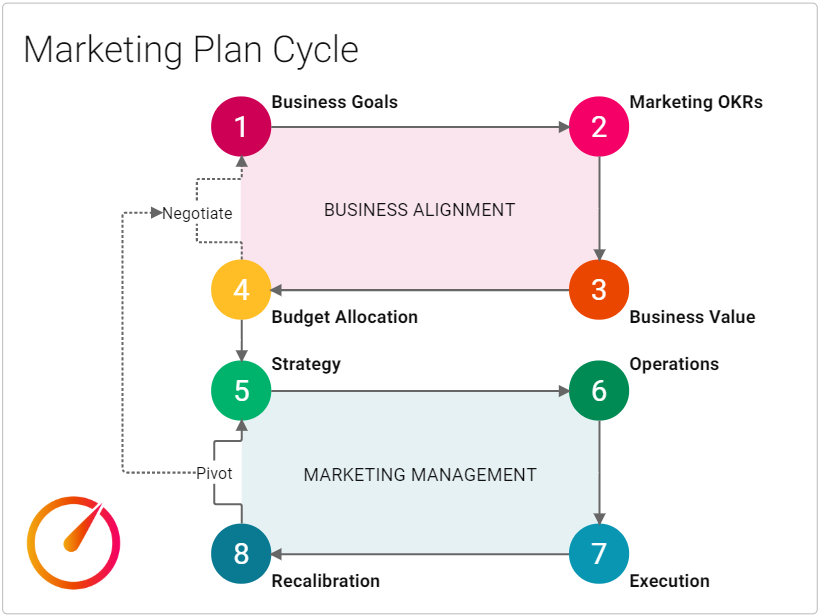When approaching any broad and complicated business problem, it's necessary to follow a systematic and structured approach; and building the marketing function of any business is uniquely challenging. Marketing is arguably the broadest function in an organization touching everything including corporate strategy, product positioning, customer experience, talent recruitment and retention - not to mention revenue and overall valuation. You can easily become overwhelmed and not where to begin.
To help you overcome a bad case of "analysis paralysis", here's a step-by-step guide to compartmentalize and build your marketing function. This 8-step cycle consists of two loops - Business Alignment and Marketing Management.

Business Alignment
Before you can truly get into your Marketing Plan, you need business alignment.
- Business Goals: Always start with the “why”. In fact, every department/function should be working to the same clearly articulated “why” statements for the business. What is the mission, the vision… the one-year and five-year definition of success. This is critical to not only give marketing focus, but also to optimize synergy and cooperation across the entire business.
- Marketing OKRs: Ask yourself "what can/should marketing do to achieve or influence these business goals? State these as Objectives and follow them with Key Results - OKRs. These must be clearly defined, within your control, and measurable. Now, Marketing's mission is achievable and aligned to impact the business goals.
- Business Value: Your Key Results will name certain “outcomes”. You need to put a price tag on these outcomes. What are they worth to the business. For some outcomes (i.e. Customers, Opportunities, Leads) this is pretty simple. For others (i.e. website visits, PR placements), this can be more difficult. See “How to Quantify the Business Value of Marketing” for more help. With your Key Results defined and your Outcomes valued, you need to set a target return on your marketing investment. What multiple are you looking to achieve per outcome? You certainly don't want your marketing plan to just break even.
- Budget Allocation: You've now established a target Cost Per Outcome (CPO) to build and allocate a budget that is formulated to achieve OKRs that are aligned to business goals. This is a beautiful thing! No doubt you'll have to negotiate. But now you can justify the trade-offs. If your proposed budget is too high, then perhaps the business goals are not realistic.
Marketing Management
With the business-side ready, now you have the necessary context in which to truly develop the Marketing Plan - the strategy, the operations, and the tactical execution.
- Strategy: The business alignment above has defined your mission and the resources at your disposal. How will you achieve it? That is your strategy. Dig into the target market, the competition, and the approach (strategy) that's going to be the most effective.
- Operations: How will you implement this strategy? Which channels will you use and what standard operating procedures (SOPs) will maximize your quality and efficiency? Define your platform (Martech), your processes, and the people involved to make it happen.
- Execution: During execution, define an appropriate means of monitoring and management. Think of what's the most productive way to manage campaigns and projects. Consider the most useful format and cadence for status meetings. Promote creativity and collaboration without sacrificing efficiency.
- Recalibration: Your company, your competition, your market, your customer… none of these are static. Consider major intervals in which to possibly do significant recalibration of your plan. Typically, this is quarterly. It could be bi-annually. Too frequently could simply be counterproductive and lead to chaos. Whatever is practical for your team to execute, count on the need to make adjustments that trickle down from your Strategy. In rarer cases, perhaps driven by a major event like an acquisition, your recalibration may go all the way back to Business Goals.
I suggest both portions, all eight steps, should be captured and kept front-and-center as your Marketing Playbook. Your team needs to count on its accuracy and relevance.
Remember, marketing is an iterative process, and it's crucial to keep experimenting, learning, and adapting to stay ahead in the ever-changing business landscape.